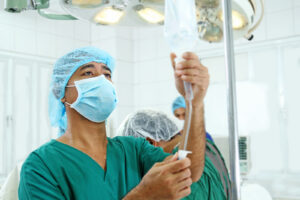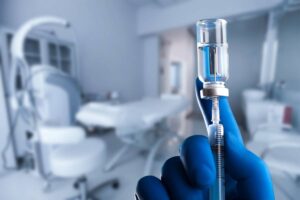Nosocomial infections (those acquired or occurring in a hospital) are responsible for, respectively, 7% and 10% of infections in developed and developing countries 1. Airborne transmission specifically accounts for approximately 10% of all nosocomial infections. Historically, airborne transmission has been the main route of infection for tuberculosis and aspergillosis, and implicated in nosocomial outbreaks of Methicillin-resistant Staphylococcus aureus (MRSA), Acinetobacter and Pseudomonas bacteria, and most, recently, COVID-19 infections. Airborne infections are particularly pernicious because they are highly under-diagnosed, given that many pathogens remain viable despite being non-culturable and many infections result from the airborne transportation of pathogens onto surfaces 2. Ensuring air purification in hospitals is key to preventing airborne, healthcare-associated infections 3.
First, air can be recirculated with outside air according to a finetuned ratio of indoor-to-outdoor air. This can be done through natural ventilation, such as by opening windows, or mechanical ventilation, such as through different heating, ventilation, and air conditioning (HVAC) systems.
Second, air filtration can be used to remove a number of airborne microorganisms. A 2021 study focusing on the airflow, transmission, and clearance of aerosols in a clinical context, and impact thereon of portable air cleaners, found that air cleaners were highly effective at clearing out aerosols from the air and reducing their spread throughout a hospital. Only two small air cleaners in a single patient room resulted in the clearance of 99% of aerosols within 6 minutes 4. Consistently, a more recent 2021 study probing the use of air purifiers in intensive care units found that using air purifiers alongside HVAC systems in hospitals would reduce the microbial load both in circulating air and on surfaces, thereby decreasing hospital-acquired infections 5. However, on an ongoing basis, such equipment should be monitored to ensure correct function while airflows are examined for filtration performance.
Third, research has also pointed to the potential of upper room ultraviolet light being used to kill pathogens 6. A 2020 study to this end found that ultraviolet-C (UV-C) sterilization was an efficient germicidal agent, all the while cautioning that an exact standard for safe exposure dose for humans has yet to be developed in light of the negative physiological side effects of too much irradiation 7.
Alongside air purification measures, personal respiratory protection should continue to be used by all patients and medical personnel when indicated to further reduce the spread of healthcare-associated infections. This includes wearing surgical masks, or powered air-purifying respirators, as some studies suggest 8, to provide a physical barrier against spreading airborne particles through breathing. A 2021 study probing the impacts of hospital-wide bioaerosol treatment and COVID-19 mitigation measures on clinical outcomes confirmed, to this end, that the addition of air disinfection technology alongside COVID-19 mitigation measures reduced airborne ultrafine particles, hospital bioburden, and healthcare-associated infections.
Air purification systems ensuring good air quality are both cost-effective and easy to deploy across a variety of healthcare settings. However, no single technology or procedure will entirely eliminate healthcare-associated infections. Proper staff training with regard to biosafety, education and awareness campaigns focused on nosocomial infections, and thorough waste management can also help reduce the burden of airborne infectious diseases. In the meantime, in the context of the current COVID-19 pandemic, it is critical for individuals to continue to practice safe distancing, wear surgical masks, and get vaccinated.
References
1. Khan, H. A., Baig, F. K. & Mehboob, R. Nosocomial infections: Epidemiology, prevention, control and surveillance. Asian Pacific Journal of Tropical Biomedicine (2017). doi:10.1016/j.apjtb.2017.01.019
2. Beggs, C. B. The airborne transmission of infection in hospital buildings: Fact or fiction? in Indoor and Built Environment (2003). doi:10.1177/1420326X03012001002
3. Air Filtration Systems Reduce The Risk Of Hospital Infections – Extract All. Available at: https://www.airsystems-inc.com/air-purification-news/air-filtration-systems-reduce-the-risk-of-hospital-infections/.
4. Buising, K. L. et al. Use of portable air cleaners to reduce aerosol transmission on a hospital coronavirus disease 2019 (COVID-19) ward. Infect. Control Hosp. Epidemiol. 1–6 (2021). doi:10.1017/ICE.2021.284
5. Arıkan, İ. et al. Effectiveness of air purifiers in intensive care units: an intervention study. J. Hosp. Infect. (2022). doi:10.1016/j.jhin.2021.10.011
6. Escombe, A. R. et al. Natural ventilation for the prevention of airborne contagion. PLoS Med. (2007). doi:10.1371/journal.pmed.0040068
7. Ramos, C. C. R. et al. Use of ultraviolet-C in environmental sterilization in hospitals: A systematic review on efficacy and safety. Int. J. Health Sci. (Qassim). 14, 52 (2020). doi: 10.5281/zenodo.3933425.
8. Sreeramoju, P. V. & Cadena, J. Airborne precautions and personal protective equipment: The powered air-purifying respirator-only approach. in Infection Prevention: New Perspectives and Controversies (2017). doi:10.1007/978-3-319-60980-5_30
9. Ereth, M. H. et al. Healthcare-associated infection impact with bioaerosol treatment and COVID-19 mitigation measures. J. Hosp. Infect. (2021). doi:10.1016/j.jhin.2021.07.006




